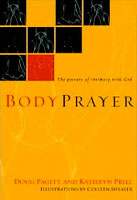
by Bob DeWaay
Doug Pagitt, Emergent Church leader, wrote a book (coauthored by Kathryn Prill) that claims that using various body postures can bring people closer to God and deepen one’s life of prayer.1 Here is an example of some of the claims of this book:
Engaging the body in acts of being present with God, including certain ceremonial practices, opens us up to God in new ways. People of faith in ancient times understood that such physical acts and practices as rest and worship, dietary restrictions, and mandated fabric in their wardrobes were of great value to their faith and life.2
The problem is that the Bible says that these types of practices are of NO value:
If you have died with Christ to the elementary principles of the world, why, as if you were living in the world, do you submit yourself to decrees, such as, “Do not handle, do not taste, do not touch!” (which all refer to things destined to perish with the use)– in accordance with the commandments and teachings of men? These are matters which have, to be sure, the appearance of wisdom in self-made religion and self-abasement and severe treatment of the body, but are of no value against fleshly indulgence. –Colossians 2:20-23
Furthermore, creating dietary restrictions for religious reasons is called a “doctrine of demons” –1Timothy 4:1-5
Pagitt claims that we can connect with God through body prayers. He calls his approach a “deeper” form of prayer:
This book is meant to be a companion and a guide into deeper forms of prayer; this book is not a specific prescription of how prayer must be done.”3
 I appreciate that he does not claim that these postures are mandatory. But that introduces an important question: if his postures are not mandated by Scripture (and they are not) how can they be “deeper” than the sort of prayer the Bible does teach? Such claims are the problem with all the “prayer secrets” books. Why is praying to God in the manner taught in Scripture so inadequate that people need to discover new practices that are superior to those Jesus and His apostles taught? Would God withhold something so good and important to all but those spiritual innovators who discover the secret? The Bible says, “Seeing that His divine power has granted to us everything pertaining to life and godliness, through the true knowledge of Him who called us by His own glory and excellence” (2Peter 1:3). God did not forget to reveal to the Biblical writers key practices we need.
I appreciate that he does not claim that these postures are mandatory. But that introduces an important question: if his postures are not mandated by Scripture (and they are not) how can they be “deeper” than the sort of prayer the Bible does teach? Such claims are the problem with all the “prayer secrets” books. Why is praying to God in the manner taught in Scripture so inadequate that people need to discover new practices that are superior to those Jesus and His apostles taught? Would God withhold something so good and important to all but those spiritual innovators who discover the secret? The Bible says, “Seeing that His divine power has granted to us everything pertaining to life and godliness, through the true knowledge of Him who called us by His own glory and excellence” (2Peter 1:3). God did not forget to reveal to the Biblical writers key practices we need.
Pagitt teaches the same “breath prayers” that we have discussed in other articles:
As you begin to pray, close your eyes. Then inhale and exhale with deep breaths. Put your hands in a comfortable position, consider turning both hands palms up. Notice the tension in your head – and let it go as you take in a deep breath – and then exhale. Notice the tension in your shoulders and let it go, again by breathing in and then out. Notice the tension in your stomach and let it go. Move down your body doing the same.4
Concentrating on one’s breath is a way to achieve an altered state of consciousness. Jesus told us to ask the Father in His name, which we can do when fully conscious and requires no prior stress relief practice.
GFM Note: In Chapter 8 of our DVD, The Submerging Church, we also show Emergent leader Rob Bell teaching breathing techniques. Here is a sample clip of that portion of our video:
Some of the postures are similar in that they seem more like a technique for self awareness. One is pressing fingertips together:
There is a theory that pressing each fingertip to its corresponding fingertip activates a certain portion of our brain. Also, it is one of the gentlest ways to feel our own pulse.5
Doing some of these practices is even confused with reconciliation which one comes through the finished work of Christ received by faith:
Start in a sitting position. Then use your arms to push your body up so you are standing. Inhale deeply through your mouth. Let your shoulders fall, release any stress in the top of your legs, and let your hips fall forward. Feel pressure on the bottom of your feetóand in that space alone. Keep breathing deeply. Allow the deep breaths to prepare you and arm you for the work of reconciliation.6
Reconciliation does not happen through some physical process, but through Christ’s blood atonement which we have received by faith (Romans 5:9-11).
It is not surprising, given the theology of the Emergent Church, that Pagitt’s approach is infused with theological immanence at the expense of transcendence. He writes:
So we extend to the rest of the world this hope: that good will be saved and increased and that God’s dreams will be done on earth as they are in heaven.7
Pagitt claims that we are co-re-creators of the world:
God is never finished with creation, and God is never finished with us. We are constantly being re-created, and we are invited to join God as co-re-creators of the world.8
There is no cataclysmic, future judgment of the cosmos in the theology of most Emergent Church leaders. Rather God is working in the world to transform it into a better place through the processes of history.
Pagitt’s terminology reflects a rather panentheistic worldview that is infused with God in some, not totally explained, way:
There is a rhythm to life. We find it in the ocean tides, in the rising and setting of the sun, in the beating of our hearts. And there is a rhythm of God–a rhythm that encompasses life, both the life we can readily see and the unseen life of the spirit. The rhythm of God beckons us, guide us, and dwells in us.9
This highly immanent theology implies that God is in the creation to be discovered, and not as the transcendent One who can only be known by His self-revelation in the authoritative Scriptures and in Christ who came in the flesh and ascended into heaven. Pagitt says, “As those who are created in the image of God, we are endowed with this rhythm.”10 Since all human beings are created in God’s image this is a universal statement, not limited to those who have been converted through the gospel. He continues, “We can find it [the rhythm of God], step into it, and live in it. This is the kingdom of God – to live in sync with the rhythm of God.”11
Sadly, the processes of “body prayer” described in this book reflects a theology that is gleaned not from authoritative Scripture but from creative efforts to create a version of prayer that is in keeping with the sensibilities of the postmodern culture. Key ideas that the Bible teaches about prayer (coming to God on His terms, grace for sinners, how we have access to God only because of the blood atonement, that God hears Christians who ask according to His will, etc.) are missing from this book. The techniques and teachings found in the book are not taught in the Bible. So the bigger question is whether God has spoken and revealed how we can come to Him or whether the means of access to God are discovered in the creation. Pagitt and his co-author leave us searching for the “rhythm of God” in the creation by means God has not ordained.
1. Doug Pagitt and Kathryn Prill, Body Prayer, (Colorado Springs: WaterBrook Press, 2005) For simplicity I will refer to Pagitt as the author with no slight intended to Prill as the co-author.
2. Ibid. 3.
3. Ibid. 8.
4. Ibid. 11.
5. Ibid. 36.
6. Ibid. 53.
7. Ibid. 103.
8. Ibid. 27.
9. Ibid. 127.
10. Ibid.
11. Ibid.






You can trust Paggitt, Bell, Jones and McLaren or The Book. 100 out of 100 times you should go with The Book.
Wow – if I needed another reason to think Doug Pagett is on to something holy and true all I must do is read this fear-filled post!
Have you ever read, “All truth is God’s truth”? It’s Augustine. God and God’s truth is so expansive that it can’t only be contained in the words alone. (As the psalmists so often expressed as they looked at the heavens).
Praying with our bodies has been a aspect of holy ones through the various ages. This book is likely a great contribution to others. Your fears notwithstanding.